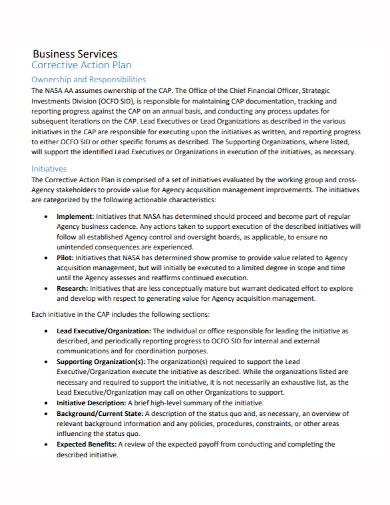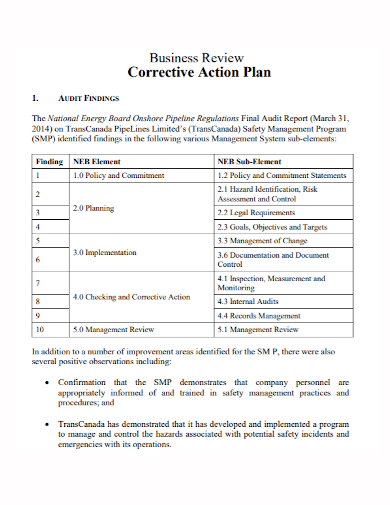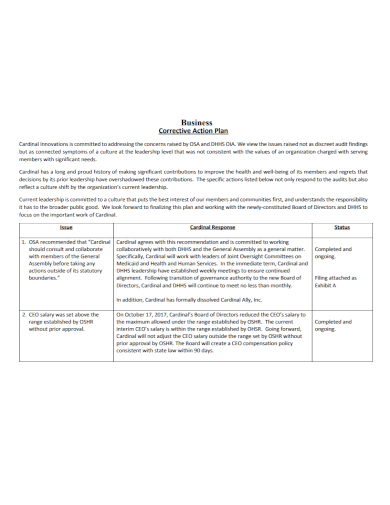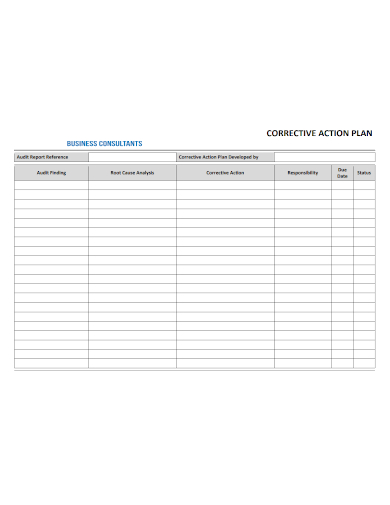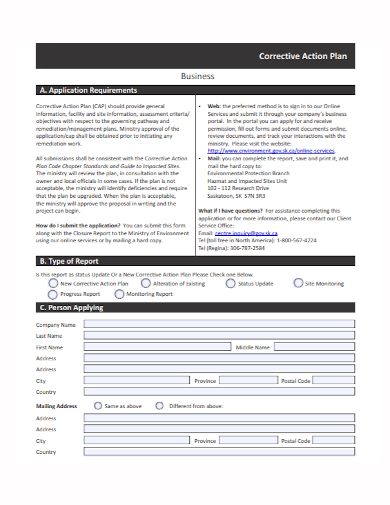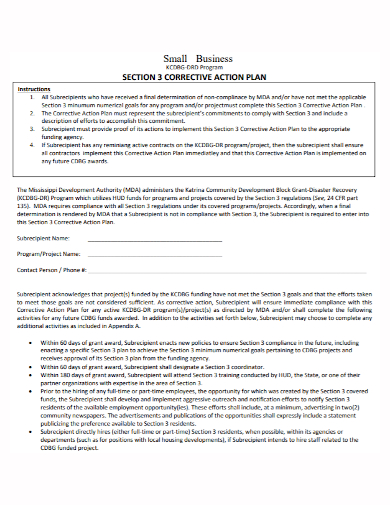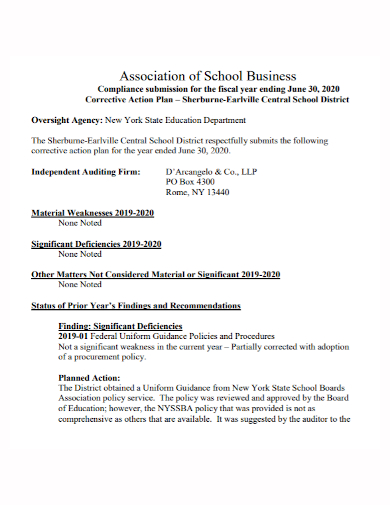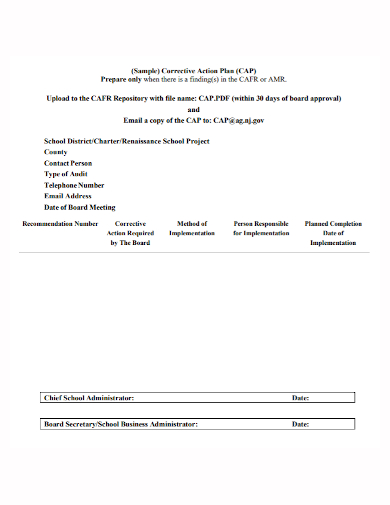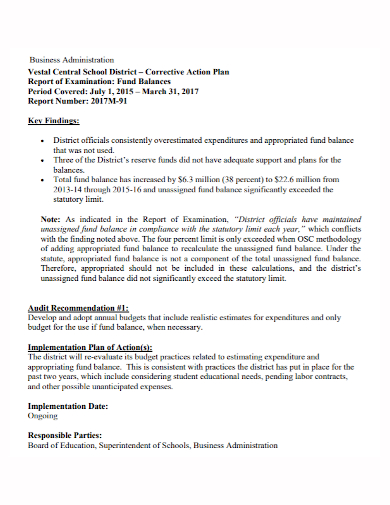A corrective action plan is a document that outlines how a specific situation will be altered in order to better satisfy a company’s objectives. It’s a reaction to a scenario that’s causing firm problems. Auditors may have discovered anomalies in inventory figures reported in financial accounts, for example. Poor inventory monitoring has been highlighted as a concern, and the corrective action plan will detail how this will be addressed. Another scenario could be sales that fall short of expectations. The sales manager may be requested to develop a corrective action plan outlining how he intends to increase sales in order to reach the year’s budgeted sales targets.
A corrective action plan assists businesses in laying out the procedures necessary to remedy an incident that is interfering with their operations. When businesses employ these, they can start to streamline their processes and eliminate errors. Understanding the many components that make up a corrective action plan might assist you in developing one for your company. It’s a document that aims to achieve specific results in order to put an end to undesired behaviors. These keep track of what each party should do to remedy an unfavorable action. Corrective action plans are used by businesses when an issue is found that has the potential to negatively impact the company’s quality management system. When effectively implemented, these strategies can aid in the improvement of business operations and the resolution of work-related challenges.
10+ Business Corrective Action Plan Samples
1. Business Services Corrective Action Plan
2. Business Review Corrective Action Plan
3. Business Investigation Corrective Action Plan
4. Business Audit Corrective Action Plan
5. Sample Business Corrective Action Plan
6. Business Consultation Corrective Action Plan
7. Standard Business Corrective Action Plan
8. Small Business Corrective Action Plan
9. Business Association Corrective Action Plan
10. School Business Corrective Action Plan
11. Business Administration Corrective Action Plan
Elements of Business Corrective Action Plan
- Defined problem – Identifying the problem is the first step in a remedial action plan. You can uncover viable answers by first knowing the problem the company is facing. This also aids your team in comprehending what you need to accomplish. It also aids in determining which team is involved in the problem, such as the quality management team in the instance above. Include links to relevant sources that support the problem you’ve outlined.
- Due dates – The company’s corrective action plans include timelines for completing the actions to obtain the intended resolution. Organizations can make lists of what chores they need to perform each day, prioritizing the actions that will help them achieve their goals. This section may also discuss the ramifications of failing to meet the deadline.
- Risk assessment – Risk assessments assist businesses in determining the level of risk associated with specific actions. Organizations utilize their risk assessment matrix to estimate the amount of risk in order to exclude high-risk actions while building a corrective action plan. Reviewing risks is also beneficial at the end of the corrective action phase since it helps organizations to determine if their efforts were successful in resolving the problem or if they need to restart the process.
- Root cause – Find the root cause of the problem to aid in the search for a possible solution. A root cause analysis can be done using a variety of approaches and techniques. When a consumer complains about a broken item, the corporation can use the why analysis to determine that the item was broken because the box fell during shipping.
- Action items – The corrective action plan outlines how the organization intends to address the identified issue. Include details to assist explain what you’re doing, such as a description of the repair plan you’ve chosen. The prices and job assignment are two other things to think about while making a list of action items.
- Stakeholders – Determine who the stakeholders are at the planning stage of the corrective action. Customers or staff are frequently the ones that are impacted. Companies frequently notify stakeholders as soon as feasible about the solutions they want to deploy.
- Metrics for competition – Corrective action plans also include completion targets or a baseline for the organization to meet before the issue is considered fixed. A corporation dealing with a disgruntled consumer due to a faulty item might use a satisfied customer as a completion metric.
- Progress updates – Corrective action plans also include completion targets or a baseline for the organization to meet before the issue is considered fixed. A corporation dealing with a disgruntled consumer due to a faulty item might use a satisfied customer as a completion metric.
FAQs
Why do you have to plan the process?
The planning phase of a corrective action system is where decisions are made on the framework and mechanics of the system, as well as how to integrate it into present operations. Personnel responsibilities for the corrective action process should also be addressed in the planning.
Why do companies use corrective action plans?
Corrective action plans are used by businesses when problems develop that could jeopardize the organization’s safety or quality. This can also involve positive events, such as when a company undergoes a transformation.
The goal of corrective action is to rectify and resolve employee performance issues so that the employee can remain a productive part of the team. Instead of being a punitive measure against the employee, the corrective action procedure should be a positive collaboration between the supervisor and the employee to achieve the necessary improvement.
Related Posts
FREE 10+ Manufacturing Corrective Action Plan Samples in MS Word | Google Docs | Apple Pages | PDF
FREE 10+ Project Corrective Action Plan Samples in MS Word | Google Docs | Apple Pages | PDF
FREE 10+ Audit Corrective Action Plan Samples in MS Word | Google Docs | Apple Pages | PDF
FREE 10+ Incident Corrective Action Plan Samples in MS Word | Google Docs | Apple Pages PDF
FREE 10+ Remediation Action Plan Samples in MS Word | Google Docs | Apple Pages | PDF
FREE 10+ Assessment Action Plan Samples in MS Word | Google Docs | PDF
FREE 10+ Workplace Emergency Action Plan Samples in MS Word | Google Docs | Apple Pages | PDF
FREE 10+ Business Emergency Action Plan Samples in MS Word | Google Docs | Apple Pages | PDF
FREE 10+ School Emergency Action Plan Samples in MS Word | Google Docs | Apple Pages | PDF
FREE 10+ Event Emergency Action Plan Samples in MS Word | Google Docs | Apple Pages | PDF
FREE 10+ Church Emergency Action Plan Samples in MS Word | Google Docs | Apple Pages | PDF
FREE 10+ Recruitment Action Plan Samples in MS Word | Google Docs | Apple Pages | PDF
FREE 10+ Earthquake Action Plan Samples in MS Word | Google Docs | Apple Pages | PDF
FREE 10+ Disciplinary Action Plan Samples [ Progressive, Corrective, Student ]
FREE 10+ Diabetes Action Plan Samples [ Emergency, School, Prevention ]

